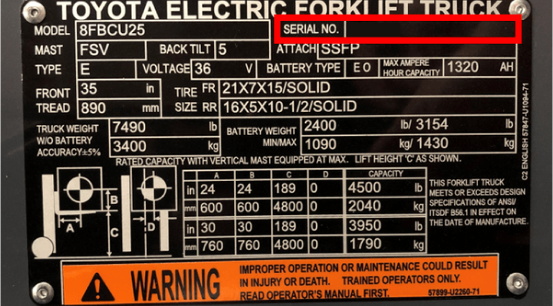How to Find Your Equipment Model Number.
Finding the right parts for your equipment is easy when you have your model and serial number which can be found on the data plate. Luckily, a forklift data plate is installed on every truck on the market to help you understand what your forklift can do and provide vital information.
Model Number: The model number of your toyota forklift is extremely important for relaying information to your dealers about repair or technical assistance and for looking up replacements part!
Serial Number: The serial number on your lift is the most important number.The model serial number combination will allow us to provide you with the parts that will fit your particular piece of equipment.

How to Find Your Equipment Serial Number
Finding the right parts for your equipment is easy when you have your model and serial number which can be found on the data plate. Luckily, a forklift data plate is installed on every truck on the market to help you understand what your forklift can do and provide vital information.
Model Number: The model number of your toyota forklift is extremely important for relaying information to your dealers about repair or technical assistance and for looking up replacements part!
Serial Number: The serial number on your lift is the most important number.The model serial number combination will allow us to provide you with the parts that will fit your particular piece of equipment.

Need some help? For further assistance or more information, contact your local Toyota Dealer.

Please click below to sign in to your MyToyota account
Don't have an account?
What Is a Site Survey, and What Can It Tell You About Your Operations?

What Is a Site Survey?
A site survey is when a trained warehouse consultant visits a work space to help maximize the business’ work place through racking, equipment, and a multitude of other factors. Their job is to help a business work as efficiently as possible and utilize all the space a company owns. But why should you think about getting one? Below are a few reasons.
Warehouse Operation Efficiency
Once a warehouse consultant comes on the scene at the time and date arranged specifically for the site survey, it doesn’t take long for them to identify opportunities that can carry already profitable business even further.
For example, let’s say a company is pulling pallets with a reach truck, bringing the pallets down, removing the product, and then putting the pallet back up onto the racking unit. In this case, a Toyota order picker may be a more optimal equipment choice to get the job done.
Often times, companies have already thought of this, but their response as to why they haven’t done it yet is usually: “We’ve always done it this way.” Those words echo through warehouses and distribution centers nationwide, and often deter operations managers from making the moves they must make in order to meet the changing demands of the modern-day distribution environment.
For those companies that do embrace change, a site survey typically starts by inventorying all forklifts and determining how that equipment is being used in the facility.
Warehouse Storage
On the warehouse floor, a site survey can help detect storage problems (e.g., stacks of pallets that are pushed into corners using hand pallet jacks), inventory management issues, and poor use of vertical space. There are times when managers say they don’t have enough space, but only have product stacked 12 feet high in a building with 25 foot ceilings. This is an opportunity for the warehouse to grow up, instead of out. The site survey will also help determine the best equipment for this type of application, such as order pickers, reach truck, or a combination of both.
All of these steps culminate into a complete warehouse optimization package designed to help operations achieve and exceed their customer service, safety, and profitability goals. By getting material handling professionals involved early in the process, these operations may be able to optimize their space and equipment in a way that they may not have been able to handle on their own.
If you would like to learn more about site surveys and warehouse consultations, download our free E-book, “Making the Case for Warehouse Consultants.”